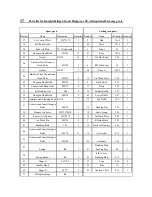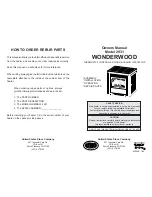
therfore leaving the tertiary air intake fully open and unrestricted when burning wood.
The primary air supply, where air passes up through the riddling grate, is controlled using the lever
air control situated below the glass on the front door, turn clockwise to close and anti clockwise to
open.
The secondary air (air wash system), which is supplied to the combustion over the glass, is
controlled using the upper air control lever, move to the left to close and to the right to open.
A third air inlet (normally named tertiary air) provides a constant, pre-heated air supply to the
combustion just above the fire, this is controlled using the push, pull air control below the ash lip
between the legs of the stove. This air supply normally does not require to be regulated. Normally it
will be necessary to keep this air supply open. The tertiary air control
must be
set to the fully open
position therfore leaving the tertiary air intake fully open and unrestricted when burning wood.
The exact positioning of the air controls to achieve optimum burn for the
Knightsbridge SE
and
Highgrove SE
will depend on many factors such as weather conditions, chimney size and local
topography. However, to give some guidance, if you adjust your settings so that two medium sized
logs (total weight 1.5kg) or half this weight of smokeless fuel burn for about an hour before needing
to refuel, then the appliance is operating at about 4.9Kw. This is the maximum amount of fuel that
should be used.
3.2.1 Use with wood: See figure 4
Important:
The
Tertiary air control
must be
set to the fully open position therfore leaving the
tertiary air intake fully open and unrestricted when burning wood.
Lighting & re-fuelling
Very Important:
1)
To achieve clean burning and maximize the performance and efficiency of the appliance it is
important to raise the temperature of the stove and chimney as quickly as possible. Thus when
lighting the appliance, the technique is to start with a small amount of kindling with all air
controls fully open and maybe the door slightly ajar. Then after a few (~5) minutes, some larger
pieces of wood should be added. Only when these have been well-alight and the flames dying
down, should the normal sized logs be added. After 2 – 3 minutes, when these logs are well
alight, the primary air control (and door) should be closed, but it is advisable that this first fuel
load be operated with the secondary air control fully open so that the room heats up quickly and
the stove reaches its optimum operating temperature.
Refuelling on a low fuel bed.
If there is insufficient burning material in the fire bed to light a new fuel charge, excessive
smoke emission can occur. Refuelling must be carried out onto a sufficient quantity of glowing
embers and ash that the new fuel charge will ignite in a reasonable period. If there are too few
embers in the fire bed, add suitable kindling to prevent excessive smoke.
2)
When re-fuelling the appliance, open the primary and secondary air controls for 2-3 minutes, or
until the logs are well alight, before closing the primary air and adjusting the secondary air to
the desired setting.














































